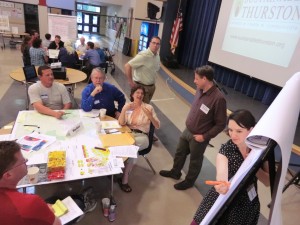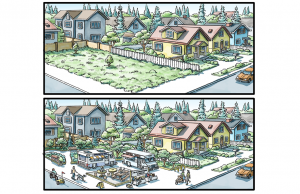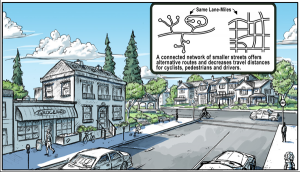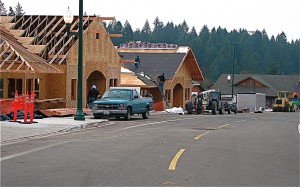
By Amy Rowley
 I gather organic eggs from my backyard chicken coop. I diligently compost our kitchen scraps. My neighbor and I carpool between school and home. Most of our summer vegetables are grown in our garden. Of course I recycle and I’m trying to alter my family’s habits regarding consumption and waste.
I gather organic eggs from my backyard chicken coop. I diligently compost our kitchen scraps. My neighbor and I carpool between school and home. Most of our summer vegetables are grown in our garden. Of course I recycle and I’m trying to alter my family’s habits regarding consumption and waste.
While my actions may make an impact in my family’s carbon footprint, I certainly recognize that there are larger sustainability issues facing our community.
Indicators predict continued population growth in Thurston County over the next 20 years. In addition, demographics will be shifting with more older and younger residents. Where will people live? Do we have the rural space to feed more people? Are there ample green spaces and parks available for recreation? How do we offer more housing and transportation choices that meet the needs of all ages and incomes?
Over the past two years, Thurston Regional Planning Council (TRPC) has been asking those questions to both policy makers and the general public.
Now in its second phase of the public process, TRPC has launched www.engagesustainablethurston.org – a website to capture the public’s opinions and comments about creating a sustainable future.
“This is truly a community-wide conversation. We heard what people love about where they live and what would make it better. A wide variety of leaders and residents from throughout the region have shaped those ideas into draft visions, identified challenges and some strategies to address them. We’re talking about the future of the region. Now we need to hear what people think about the draft visions and ways to achieve them,” says Kathy McCormick, Senior Planner at TRPC. “We want to know what people think and are offering a variety of ways for residents to get information and share their ideas.”
The EngageSustainableThurston.org online opportunity takes just a few moments, but is intended to be a place where anyone can share ideas, respond to others’ ideas and answer some questions. Questions will rotate – participants will be notified when they do – and anyone can return to the site to see what others are saying. This is a fresh and fun experiment in a new form of public engagement. Let your voice be heard.
Research and Previous Work
A lot of work has gone on to get us to the point of public comment.

To begin with, TRPC convened a panel of local experts that have been exploring the following topics related to sustainability and the future growth of Thurston County.
- Economic sustainability
- Housing
- Land use, transportation, and climate change
- Water, sewer and stormwater
- Solid waste
- Public safety
- Public health and human services
- Energy
- Local food systems
- School siting and transportation in North and South county communities
Each panel developed a vision statement and a comprehensive list of goals. In each document, the panel discusses what’s already working, anticipates issues and challenges and then relates their topic to the others.
The issues are quite complex and inter-related. Take, for instance, the topic of housing. Population data report that Thurston County demographics will be shifting towards larger populations of senior citizens. McCormick notes that seniors may want to move from their suburban or waterfront home into a smaller space, closer to services and transportation options. Add in a safe place to walk and access to medical care and you have created a sustainable community for a healthy lifestyle as an individual ages. Clearly tackling just this one topic – housing – requires the coordinating of private, public and non-profit agencies.
Each panel reported their findings. The Sustainable Thurston Task Force then digested all the information and created a draft definition of sustainability that you can comment on at EngageSustainableThurston.org.
Creating Place and Preserving Space
Phase one resulted in two major themes – creating place and preserving space.
“It was clear from the first round of discussions that people want vital city centers in both north county and south county towns as well as more focused activity and opportunity for more jobs, housing and shopping opportunity in those places,” says McCormick.

Along with creating place, the public also resoundingly talked about preserving the current agricultural and green spaces in Thurston County.
One key ingredient to preparing for growth is leveraging current infrastructure. “We currently have a wonderful network of roads, sewer and water that will take maintenance over time. We know that extending infrastructure will cost the region more. We need to leverage what we have and maximize its use which will save money in the long run,” she says.
This may mean concentrating new housing into existing or new neighborhoods, providing more opportunities destinations within walking distance and access to transit. McCormick explains that city center vitality comes from focusing housing and jobs in order to support business districts, and the best transit possible. Major urban transit corridors also offer opportunity for more of a mix of jobs and housing that can take advantage of whatever good transit service becomes available over time. So, to deal with transportation issues, we must also tackle housing.
“Any future high capacity transit will require enough well located housing and jobs to support it,” adds McCormick.
“We also heard from residents throughout the region that they want to keep rural lands rural,” she comments. “Even in rural areas there may be opportunities to add small services, like farmers markets, to create some activities that help achieve other goals like support of small farms and access to fresh local food.”
Working Together
“Regions that have plans in place, leverage existing resources, and offer a clear vision for the future are more economically resilient in downturn economies,” explains McCormick.
Twenty-nine public and private partners – including business groups, non-profit organizations, school districts and government municipalities – have come together through TRPC’s organizing efforts to collaborate, cooperate and leverage available funds.
With coordinated efforts, these groups will be able to apply for competitive grant funds to implement the strategic plan that will result from this effort.

“We are asking the public to check out the vision and goals that will identify the future this region wants as well as the strategies, actions, and responsibilities to get us there,” adds McCormick when emphasizing the role we each have in shaping the vision and goals for this master plan.
By the end of the year, the Sustainable Thurston Task Force will create:
- a regional plan for sustainable development,
- a new regional housing plan,
- and an action plan with performance measures to track success over time.
“Basically, the future is in the hands of each resident,” summarizes McCormick. “This is a community conversation that will result in a better future, more resilient economy, healthier environment and a vibrant community.”
Weigh in at www.engagesustainablethurston.org or visit SustainableThurston.org.
Workshop opportunities too.
If you prefer a face-to-face discussion over an online survey, participate in an upcoming open house/workshop beginning at 5:30 pm.
- Wednesday, March 27h at South Sound Manor, 455 North St. SE, Tumwater or
- Thursday March 28th at Rainier High School, Rainier.



















































